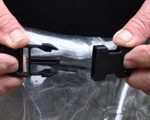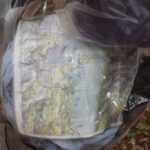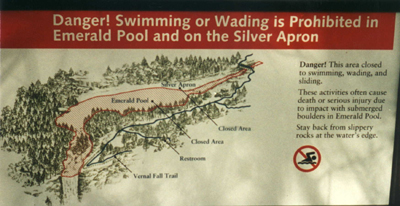The safest place to cross a stream or creek is on a bridge with a handrail that is in good repair.

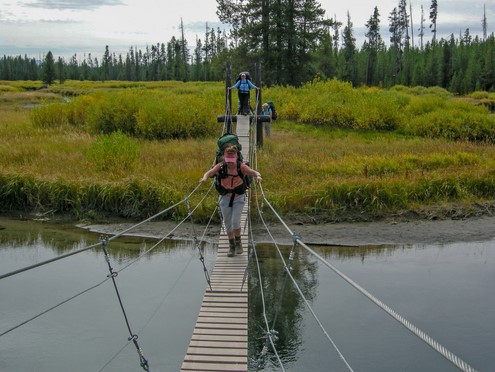
Bridges without handrails are more common and can be safe if no one is running across them, or blocking them by sitting on the edge.
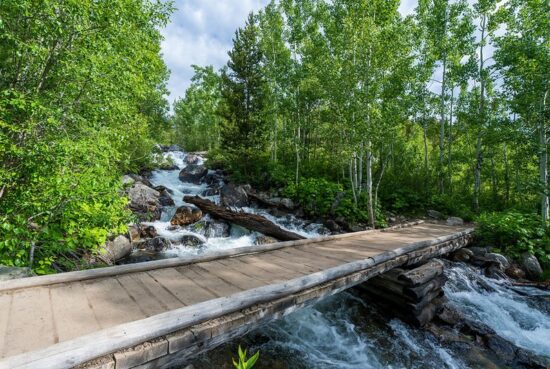
A park might have put a handrail across a tree trunk, and put it across a stream/river but it is not safe during high water, and once high water has gone over it, the handrail might become loose or rotted and not support anyone.
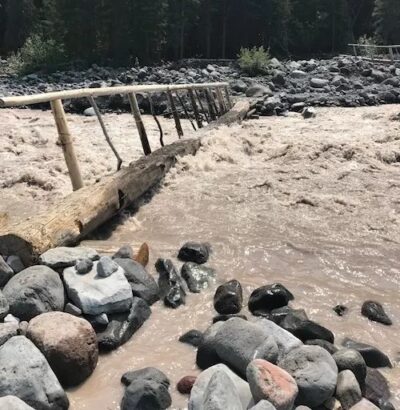
Trails you might hike go across creeks and streams at places that are safe some times of the year, but not safe, for example, when water is high.
De facto “trails,” paths worn out by people going off trail that look like a trail, can lead unsuspecting hikers and backpackers to a place to cross a stream that is not safe. A trail might go to the end of a large fallen tree trunk across a muddy river, and it make it look as though people have walked out across that tree to cross, but it is not safe, even if it were not as high above the water as this one is:
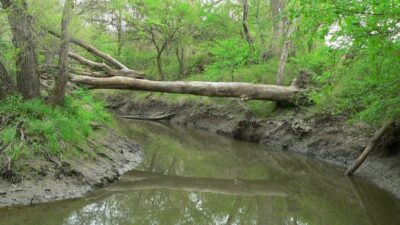
How far are you from Search and Rescue help? There is no guarantee of rescue.
There can be rows of rocks, with a surface above the water level, that look like a place you can step from rock to rock and keep your boots dry, but they are often VERY slippery. If you risk crossing at a place like this, it could be wise to have the most experienced, strongest hiker/backpacker in your group slowly cross first while others wait.
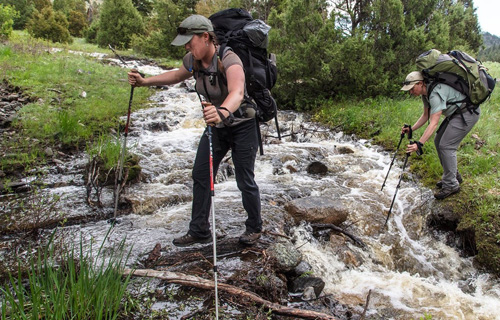
(Are you sure of your balance, especially without hiking staffs?) How far are you from Search and Rescue help? There is no guarantee of rescue.

If you have a large group, the most experienced, strongest person could carry the packs of others across for them, but be sure to have someone staying with the packs so quick critters can’t get into them.

People sometimes look across a stream/river and think that the water looks shallow enough and is not moving too fast, so they try to wade. The park service sometimes can rescue people who get themselves in trouble doing this . . . in the case of the two men seen below in a frame from a Yosemite Park safety video after they lost footing in the water and ended up on a rock midstream,

it took awhile for Yosemite Search and Rescue to get helmets and lifejackets to them to wear, and a ladder to put across the rocks for them to crawl on to safety:
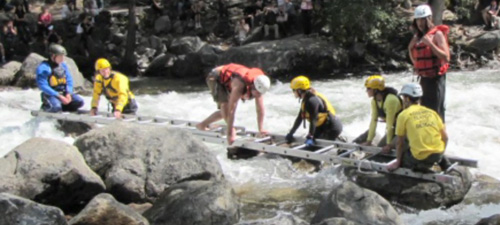
the photo above is a frame from this Yosemite National Park video:
![]()
Teton County (Wyoming) Search and Rescue would like you to know:
“Do not stand in moving water, even if shallow. If your foot gets trapped in the rocks, the current will push you over, wedging your foot tighter, and pushing your head underwater. You will drown. Others have drowned in 2 feet of water this way.”
![]()
The following advice may have changed or been updated by the locale you choose to hike/backpack in. Always check with rangers for the most current advice.
Yellowstone National Park has had this advice:
“Stream Crossings
Few of Yellowstone’s rivers or streams have bridges, and many cannot be crossed until July or later. Even in late summer, water levels can rise quickly after rainstorms or from snowmelt in the high country on warm afternoons. The water can be cold, fast, and more than thigh-deep, making any attempt to cross perilous. Trying to ford deep, swift water has resulted in loss of gear, injury, and death. Carefully check your itinerary on a topographic map for stream crossings, and ask about river conditions at a ranger station before beginning your trip. Don’t be afraid to turn around if conditions are dangerous. Before you ford a river, make sure everyone in your group is comfortable doing so.
Hypothermia
Rain, wind, sleet, and snow can be deadly if proper precautions are not taken. Always bring rain gear and extra clothes for warmth. To avoid hypothermia, stay dry, stay out of the wind, and avoid getting chilled. Put on rain gear before you get wet and warm clothes before you start shivering. Most hypothermia cases happen in air temperatures of 30–50° Fahrenheit. Wear a hat and gloves to conserve body heat.
If you cannot stay warm and dry, assess and alter your plans. Remember that you are only as strong as the weakest person in your group. Persistent or violent shivering is a clear warning that someone is on the verge of hypothermia. Other symptoms include slow/slurred speech, loss of dexterity, exhaustion, incoherence, and drowsiness. When someone is hypothermic, find shelter and make camp. Get out of wind and rain. Remove wet clothing. Get into dry clothing and a sleeping bag. Provide warm, non-alcoholic drinks.”
![]()
Great Smoky Mountains National Park has had this advice;
“Dangerous Stream Crossings
Heavy rains cause swollen streams that may be unsafe to ford. Use good judgement. Do not attempt to cross flooded streams. If your route is blocked by a rain-swollen stream, please backtrack and attempt to return to the nearest campsite or trailhead. Do not risk your life trying to follow a planned itinerary!
When crossing streams, wear shoes to protect your feet and a use stout stick for added support. Unbuckle the waist strap of your pack so it can be discarded quickly.”
![]()
Yosemite National Park published the map below of potentially hazardous creek crossings.
The map includes: “WARNING This map lists only crossings that are potentially hazardous regularly & yearly. All creek crossings can be dangerous at any time deepening on current weather and snow pack conditions. Always use caution when crossing creeks and plan ahead appropriately.”
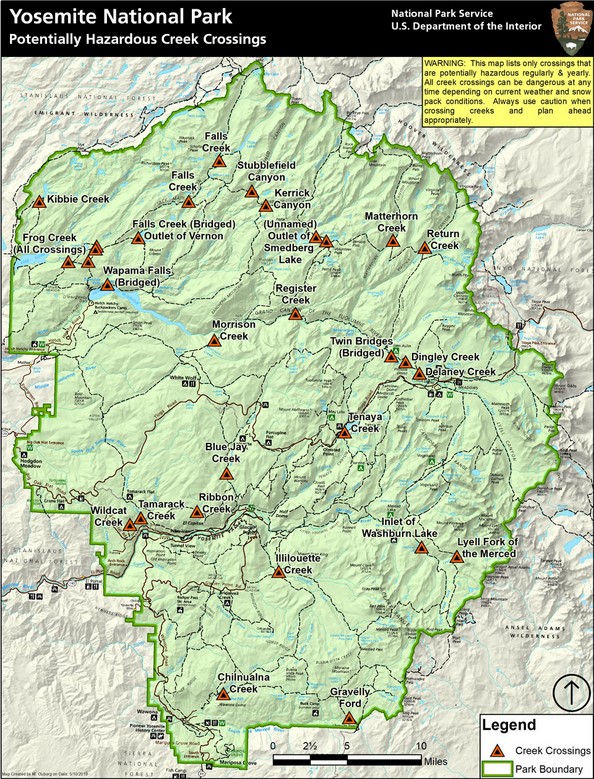
![]()
Mount Rainier National Park has had this advice:
“Crossing Streams Safely
Many hikers underestimate the power of moving water and some consider their former successful stream crossings as a ticket to the other side. This may not be true. Regardless of your knowledge, skills, and experience use the pointers below in making wise decisions when crossing a steam.
Your best option may be turning back. If conditions do not look safe or above your skill level, do not try to cross. Your safety is more important than your itinerary. Permits or reservations can be adjusted to accommodate safe river crossings.
Remember, if you hear “boom” noises as boulders or large rocks move around in river, it means the water is STRONG and FAST. In addition to the current knocking you over, you could be hit by rocks moving in the river. Be cautious when deciding where to cross rivers, or if it’s necessary to cross at all. Taking these few precautions could save your day…and your life!”
![]()
The National Park Service has had this advice
“Stream Crossing Safety
. . . Never underestimate the dangers associated with stream or river crossings.
Crossing rivers can be VERY dangerous without preparation, patience, and planning. Hikers must be familiar with safe techniques for crossing rivers and streams. Learn the signs of hypothermia – shivering, loss of manual dexterity and coordination, slurred speech, mental impairment – and know how to treat its victims by rewarming their core body temperature. Remember, no river crossing is worth your life.
Check with a ranger for current river conditions along your route prior to entering the wilderness. Make a backup plan in case the water is too high, cold, or swift to cross.
Keep these points in mind when crossing water channels:
Protect your feet:
- NEVER cross in bare feet. Crossing barefoot decreases traction and exposes your feet to submerged hazards such as boulders, logs, and lost fishing tackles.
- Wear boots or bring extra shoes for crossings. Open-toed sandals do not protect your toes from these hazards and create drag that can cause you to fall. If you do not have extra shoes, remove your socks and insoles and cross in your boots.
- Move one foot at a time, sliding it across the bottom.
- Pack wool socks. They will keep your feet warm even if wet.
Choose the safest place and method to cross:
- For general river crossings, the widest or most braided portion of the channel is usually the most shallow and straight channels usually exhibit uniform flow while bends often reveal deep cut banks and swift water on the outside edge.
- Water has less momentum on level ground than when flowing down an incline.
- If hiking solo, use a hiking staff or trekking pole, held upstream, to create a more stable, three point stance. Move only one contact point at a time.
- Two or more hikers should cross parallel to the current with the strongest and heaviest member upstream to lessen the force on the other hikers. Walk across with arms linked, or face upstream and sidestep across.
- Keep your eyes on the far shore. You may become dizzy if you look down at the swirling water.
- In deep water, the triangle method is safest. Facing each other, three people grip each others shoulders or packs and work their way across one person, one leg, at a time.
Prepare to get wet:
- Release the waist and sternum belts of your pack. Should you fall, you must be able to remove the pack before it turns you over, face down into the water, fills up with water and drags you down or becomes snagged on debris in the river. You might lose the pack if the straps aren’t connected, but consider the alternative.Be familiar with pack buckles and be prepared to shed your pack to remain afloat. Be prepared to lose your pack if you fall or trip in the river.
- Pack your essential items such as fire starters, sleeping bags, and clothes in watertight stuff sacks or plastic bags to keep them dry in case you do fall. Insulation and the ability to start a fire could save your life if subjected to cold water for long periods. This also enhances your pack’s buoyancy.
- In faster currents, face upstream and cross at a slight angle downstream. Lean slightly into the current, and shuffle-step sideways.
- Before crossing, place your communications devices and basic survival gear (fire starter, emergency space blanket, etc.) in a waterproof bag and store it on your body during the crossing. If your pack gets away and is lost, your survival may depend on these critical items.
- If a crossing seems too risky…it probably is! Always include an option for a retreat back to shore should the crossing become too difficult.
Always be willing to turn back or wait for a more suitable time if a crossing appears too dangerous!”
![]()
The Pacific Crest Trail assn has had this advice:
“Stream crossing safety while hiking and backpacking
People die in stream crossings. They underestimate the risk. It’s better to turn around than risk a dangerous crossing. Remember, most hikers delay their trips until after peak runoff. That’s the safest option.
How to assess a creek crossing for a safer place to cross.
Look downstream—and consider what happens if you get swept away.
Are there any hazards? Hazards could include waterfalls, boulders, strainers, undercut banks or bends in the river where the current gets fast and deep. If you slip and fall, you’re going for a ride. Even a light current can easily push you far downstream. Make sure there’s nothing nasty downstream that you could get pushed into. Also, make sure that the banks aren’t so steep, brushy, or snowy that you won’t be able to get out.
Beware of strainers. If there’s a log or bush in the stream, always stay downstream of it.
Crossing a swift current upstream of a submerged or nearly submerged log is incredibly dangerous. If you end up swimming in the creek, you’re very likely to get pinned against the log or its branches by the force of the current. Strainers can suck you under and keep you pinned down. It’s called a strainer because water flows through it, but a human cannot. Avoid strainers by crossing downstream of these types of hazards.
Slow, deep water is often safer than shallower, swift water.
You always have options if you make the time to create them. Look to cross where the water is slow. Cold water isn’t nearly as hazardous as a powerful current. In slow, deeper water, you can take your time and be more careful picking your foot placement on the bottom.
The physics of moving water is not in your favor. Water weighs 62.4 pounds/cubic foot and the pressure exerted by moving water increases with the square of its velocity. If water is moving twice as fast, it’s exerting four times as much force. If it’s moving 10 times as fast, that’s 100 times the force. Remember buoyancy as well. You’ll float more as the water gets deeper, which makes it even harder to stay firmly placed on the stream bed.
Consider straight stretches over bends in the river. Look for islands. Look into the water.
Where a river turns, there often will be deep pools, perhaps with undercuts. A straight stretch of a river might be faster, but it’s more likely to be of consistent speed with a uniform bottom.
If the water is clear, look closely for deep spots and smooth bottoms. Use the stream’s features to your advantage. Islands in the stream give you a break in the middle of the crossing and might mean that the current is cut in two and weaker on both sides. Sometimes crossing above a bend will mean that if you are pushed downstream, you’ll end up on the opposite shore.
Scout for safer crossings by walking up and down the river.
The trail is not always the best place to cross. You might need to walk for hours up and downstream looking for a place to cross. Don’t be lazy. It could cost you your life. Scouting can be extremely hard work. You may find yourself thrashing through brush and going cross country through rugged terrain. But look long enough and you’ll almost always find a safer place to cross. Use your map as well. Look for areas upstream of confluences where the flow is lessened or meadows where the rate of speed is reduced.
Do not take the act of leaving the trail lightly. Cross-country travel has its own significant dangers and consequences and you should learn to manage these risks before attempting it. If something goes wrong, you’ll truly be in the middle of nowhere.
Be careful if crossing a log.
Logs get you out of the current and they keep your shoes dry. But they also hold their own risks and dangers.
- Is the log securely anchored on both sides?
- Is it wet?
- Is it large enough diameter to not bend or sway when you’re on it?
- Are there branches in your way that could trip you up or catch your pack?
- Is your balance very good or more mediocre? Have you practiced crossing logs and built personal experience on them?
- Is there bark or rot that might break apart when you step on it?
What will happen if you fall? Will you fall far? What’s the landing zone like? Is it rocky or full of sharp sticks that could impale you? Will the log be a strainer that will pin you underwater if you fall on the upstream side? Fully assess the consequences.
Keep your shoes on.
Though nobody likes wet shoes, your chances of slipping and falling go up exponentially when you’re barefoot. Wearing shoes or boots also will reduce your chance of cutting, twisting, bashing or otherwise injuring your foot. Your shoes will get wet—but they’ll dry.
If the bottom is rocky, don’t move one foot before your other foot is secure.
Cross streams one step at a time. Streambeds can be ridiculously slippery, so take it slow and pick your foot placement carefully. Be as grounded as possible.
Ditch your pack if you take a swim.
If you fall in, your pack will quickly become a waterlogged anchor that will rotate on top of you and pin you down. Save yourself. Ditch your pack if you need to. Unbuckle your pack before you start your crossing so that you can quickly jettison it even if you’re panicked in a creek crossing. Realize the consequences. You may be wet, in the wilderness, with no equipment. It’s an emergency of your own creation and it’s bad news.
By the way, we hope you keep your gear in waterproof stuff sacks. You can fall and get soaked in tiny little creeks. Make sure your electronics, sleeping bag and warm clothes are protected. Also, make sure you don’t have a bunch of loose stuff hanging off your pack. It’ll catch the flow of water, pull you off balance and you’ll lose it forever. Everything should be securely attached.”
![]()
Safe River Crossings
Lake Clark National Park and Preserve, Alaska
https://www.nps.gov/articles/safe-river-crossings.htm
“Knowing how to cross rivers safely is an essential skill to master for wilderness travel in many national parks like Lake Clark National Park and Preserve. Never underestimate the danger associated with stream crossings. Alaskan waters are extremely cold, even when the air temperature is warm. Manage the risks by using the Plan > Pick > Assess > Check method.
Remember, no river crossing is worth your life. Always arrange for an alternate pickup location with your air taxi in the event you decide not to cross a river.
Plan for River Crossings
- Pack your essential items such as fire starters, sleeping bags, and clothes in watertight stuff sacks or plastic bags to keep them dry in case you do fall. Insulation and the ability to start a fire could save your life if subjected to cold water for long periods. This also enhances your pack’s buoyancy.
- Bring a spare pair of sandals or sneakers to change into. Crossing barefoot decreases traction and exposes your feet to submerged hazards such as boulders, logs, and lost fishing tackle. Open-toed sandals do not protect your toes from these hazards and create drag that can cause you to fall. If you do not have a extra shoes, remove your socks and insoles and cross in your boots.
- Pack wool socks. They will keep your feet warm even if wet.
- Pack shorts to change into for the crossing. Long pants increase drag and won’t keep you warm when wet.
- Bring a hiking pole or use a sturdy stick to provide three points of contact with the river bottom and increase your balance.
- Coiled rope and personal flotation devices are other safety items you may consider bringing along for larger river crossings.
- Think about the crossing technique you’ll use in various currents and depths and who will do what based on their experience and physical size prior to entering the wilderness (long legs and sure footedness are assets here).
- Check with a ranger or guide for current river conditions along your route prior to entering the wilderness. Make a backup plan in case the water is too high, cold, or swift to cross.
- Learn the signs of hypothermia – shivering, loss of manual dexterity and coordination, slurred speech, mental impairment – and know how to treat its victims by rewarming their core body temperature.
Pick the Time and Place
- Glacial streams are often easiest to cross in the cool, early mornings when the volume of water is lower making them shallower with a slower current. Current can rise significantly within a few hours on warm sunny days or after heavy rains, making a slow stream an impassable torrent.
- Cross at a straight section. Imagine the bends of a river forming the letter “S” – the safest place to cross is generally the straight section in the middle of the “S” between the bends. If you lose your footing, the current is likely to carry you to the bank on the outside of the bend.
- Select a route through the widest channels or where there are many channels instead of just one. As water disperses it flows slower and becomes shallower.
- If there is an island or sandbar in the middle of the stream, the current may be more manageable on either side, making it a good place to cross.
- Spend time walking up and downstream in order to find a crossing site suitable for the entire group.
- Be aware of hazards downstream and determine a rescue plan and potential take out point prior to entering the river. Never attempt to cross above rapids or falls.
- Plan on turning around, waiting it out or going elsewhere if the water is too high, too cold, or too swift.
Assess the Water’s Properties
- Toss a stick in up stream to get a feel for the water’s speed: the swifter the water the shallower it has to be to cross safely. If you cannot walk as fast the the stick is floating downstream, it is probably not a safe spot to cross.
- Standing waves indicate submerged boulders, logs, swift water, or an uneven bottom.
- Small, closely spaced ripples should be indicative of a shallower, smoother bottom. This is a better place to cross than where there are standing waves.
- Toss a rock into the water. A hollow “ka-thump” sound indicates deep water. If the rock moves downstream before sinking to the bottom, or if submerged rocks can be heard rolling downstream, the current may be too swift to cross at that point.
- Avoid crossing through water deeper than your knees if possible. The only time to wade through deeper water is when you locate a flat pool with little or no current.
- Look for another place to cross if the water is too deep or swift.
Check Any Last Minute Details
-
- Release the waist and sternum belts of your pack. Should you fall, you must be able to remove the pack before it turns you over, face down into the water, fills up with water and drags you down or becomes snagged on debris in the river. You might lose the pack if the straps aren’t connected, but consider the alternative.
- In faster currents, face upstream and cross at a slight angle downstream. Lean slightly into the current, and shuffle-step sideways.
- Maintain two points of contact with the stream bottom at all times- both feet or one foot and your pole.
- Keep your eyes on the far shore. You may become dizzy if you look down at the swirling water.
- Cross as a group when the water is especially swift or deep. The strongest person should be slightly upstream to break the current for the others. Cross in a line holding onto each other’s pack straps, side by side with arms linked, or in a tripod with arms linked.
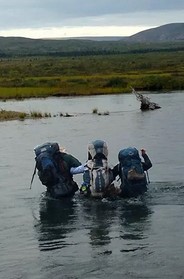
- Finally, always include an option for a retreat back to shore should the crossing become too difficult. Never over-commit yourself to one route .”
![]()
How to use a dry bag when out kayaking or to use as a waterproof bag in your backpack.
___________________________________
HIKING SECRETS and etiquette on the Hiking Advice webpage include hiking in the heat, preventing and/or dealing with blisters, logistics of hiking, a day hike gear list, Half Dome hiking advice, winter hiking and the answer to the question: When is the best time of day to cross a mountain stream?
 You can’t always expect a helicopter rescue
You can’t always expect a helicopter rescue
Depending on a GPS unit to intentionally be separated from your hiking partners can lead to confusion or even disaster. Be certain that the people you are with are happy with this prospect. GPS is not infallible
Heat illnesses (heat exhaustion and heat stroke, dehydration)
Thunderstorm and lightning safety includes the answer to the question:
Why can’t you swim during a lightning storm? A strike on a lake doesn’t kill all the fish in the lake.
When you camp at 7,000 or 8,000,or 9,000 plus feet elevation, you will probably feel out of breath at first and may even get a headache and lose appetite. You can get more sunburned. Read At altitude for advice. It includes why your tent mate might seem to stop breathing.
Can a person who is prescribed an epi-pen risk going into the wilderness? and some sting prevention notes are at: Anaphylaxis quick facts
backpacking advice has these sections: Must bring for each large group (or perhaps for each couple or person), Must bring backpacking for each person, Some (crazy?) people think these are optional for backpacking, Backpacking luxuries(?), Do not bring these backpacking, To keep down on weight backpacking, Don’t rush out and buy, BACKBACKING FOOD, Low-cook backpacking foods, Yosemite National Park WILDERNESS PERMITS.
GORP and hiking snacks includes no-cook meals. Consider this if you want to go to the top of a peak. You might not want to bring a stove at all. If you spill some boiling water on your hand, for example, you won’t have enough cold water to pour over the burn to stop the burning and ease the pain. You can get by just fine (or even be somewhat gourmet) with cold food.
Leave no trace camping has these basic principles:
Plan Ahead and Prepare
Travel and Camp on Durable Surfaces
Dispose of Waste Properly
Minimize Campfire Impacts
Respect Wildlife
Be Considerate of Other Visitors
examples and details of how easy this can be are at: Leave no trace
Enhance your drive to your next adventure: Road trip advice and etiquette
Camping solutions for women has tips for and answers typical questions from first-time women campers, including the question: Can menstruating women camp or backpack around bears?
 water in creeks, lakes, etc. is only safe to drink if you brought a water purifier.
water in creeks, lakes, etc. is only safe to drink if you brought a water purifier.
Find a compass, altitude, latitude and longitude on your cell phone
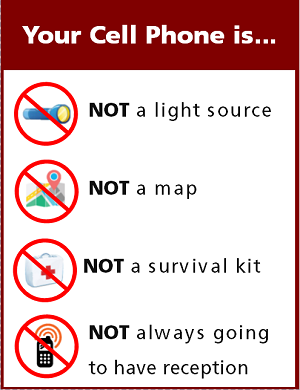
The author of this webpage, (written as a homework reading assignment for my students), does not give any warranty, expressed or implied, nor assume any legal liability or responsibility for the accuracy, completeness, or usefulness of any information, product, or process included in this website or at websites linked to or from it. Users of information from this website assume all liability arising from such use.

